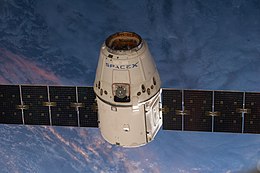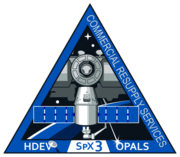
Back SpaceX CRS-3 Catalan SpaceX CRS-3 Czech SpaceX CRS-3 Finnish SpaceX CRS-3 French SpaceX CRS–3 Hungarian SpaceX CRS-3 ID SpaceX CRS-3 Italian スペースX CRS-3 Japanese SpaceX CRS-3 Latvian/Lettish SpaceX CRS-3 Polish
 SpaceX CRS-3 Dragon spacecraft approaching ISS on 20 April 2014 | |
| Names | SpX-3 |
|---|---|
| Mission type | ISS resupply |
| Operator | SpaceX |
| COSPAR ID | 2014-022A |
| SATCAT no. | 39680 |
| Mission duration | 29 days, 23 hours, 38 minutes |
| Spacecraft properties | |
| Spacecraft | Dragon 1 C105 |
| Spacecraft type | Dragon 1 |
| Manufacturer | SpaceX |
| Launch mass | 6,000 kg (13,000 lb) |
| Dimensions | Height: 8.1 m (27 ft) Diameter: 4 m (13 ft) |
| Start of mission | |
| Launch date | 18 April 2014, 19:25:21 UTC[1] |
| Rocket | Falcon 9 v1.1 (B1006) |
| Launch site | Cape Canaveral, SLC-40[2][3] |
| End of mission | |
| Disposal | Recovered |
| Landing date | 18 May 2014, 19:05 UTC |
| Landing site | Pacific Ocean |
| Orbital parameters | |
| Reference system | Geocentric orbit |
| Regime | Low Earth orbit |
| Inclination | 51.65° |
| Berthing at International Space Station | |
| Berthing port | Harmony nadir |
| RMS capture | 20 April 2014, 11:14 UTC |
| Berthing date | 20 April 2014, 14:06 UTC |
| Unberthing date | 18 May 2014, 11:55 UTC |
| RMS release | 18 May 2014, 13:26 UTC |
| Time berthed | 27 days, 21 hours, 49 minutes |
| Cargo | |
| Mass | 2,089 kg (4,605 lb) |
| Pressurised | 1,518 kg (3,347 lb) |
| Unpressurised | 571 kg (1,259 lb) |
 NASA SpX-3 mission patch | |
SpaceX CRS-3, also known as SpX-3,[4] was a Commercial Resupply Service mission to the International Space Station (ISS), contracted to NASA, which was launched on 18 April 2014. It was the fifth flight for SpaceX's uncrewed Dragon cargo spacecraft and the third SpaceX operational mission contracted to NASA under a Commercial Resupply Services (CRS-1) contract.
This was the first launch of a Dragon capsule on the Falcon 9 v1.1 launch vehicle, as previous launches used the smaller v1.0 configuration. It was also the first time the F9 v1.1 has flown without a payload fairing, and the first experimental flight test of an ocean landing of the first stage on a NASA/Dragon mission.[5]
The Falcon 9 with CRS-3 on board launched on time at 19:25 UTC on 18 April 2014,[1] and was grappled on 20 April at 11:14 UTC by Expedition 39 commander Koichi Wakata. The spacecraft was berthed to the ISS from 14:06 UTC on that day to 11:55 UTC on 18 May 2014.[6] CRS-3 then successfully de-orbited and splashed down in the Pacific Ocean off the coast of California at 19:05 UTC on 18 May 2014.[7]
- ^ a b Cite error: The named reference
gizmag20140418was invoked but never defined (see the help page). - ^ Cite error: The named reference
launchsched20120609was invoked but never defined (see the help page). - ^ Cite error: The named reference
Launch Manifestwas invoked but never defined (see the help page). - ^ Cite error: The named reference
issstatus20140414was invoked but never defined (see the help page). - ^ Cite error: The named reference
nsf20140414prelaunchArticlewas invoked but never defined (see the help page). - ^ Cite error: The named reference
nasa20140420was invoked but never defined (see the help page). - ^ Cite error: The named reference
nsf20110519was invoked but never defined (see the help page).